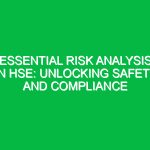Introduction
Good morning, team! Today’s Toolbox Talk focuses on an important topic we encounter often: Shift Work Dangers. As many of you know, working in shifts can have various impacts on our health, safety, and overall well-being. Understanding these dangers helps us to mitigate risks and ensure a safe and productive work Environment. Let’s dive into the critical aspects of shift work and how we can protect ourselves and each other.
What Are Shift Work Dangers?
Shift Work Dangers refer to the potential health and Safety risks that arise from working non-standard hours, such as night shifts or rotating shifts. These dangers encompass physical, mental, and emotional challenges that can affect our performance and Safety on the job. Shift work can disrupt our natural circadian rhythms, leading to fatigue, decreased alertness, and a higher likelihood of accidents.
Understanding Circadian Rhythms
Our bodies operate on a natural clock known as circadian rhythms, which are roughly 24-hour cycles influencing sleep, hormone release, and other bodily functions. When we work irregular hours, this clock can get out of sync, resulting in various health issues, including:
- Sleep disorders
- Increased stress levels
- Higher risk of cardiovascular diseases
- Digestive problems
It’s essential to acknowledge that our bodies are designed for a specific kind of routine, and when we disrupt that, we can face significant health challenges.
Key Risks Associated with Shift Work
Understanding the specific risks associated with shift work is crucial for maintaining safety. Here are some common dangers:
- Fatigue: Working long hours or during the night can lead to physical and mental fatigue, making it harder to concentrate.
- Reduced Alertness: Night shifts can impair reaction times, increasing the risk of accidents both on and off the job.
- Health Issues: Chronic shift work can lead to serious health problems such as obesity, diabetes, and mental health disorders.
- Social Isolation: Shift work can disrupt social interactions and family life, leading to feelings of isolation and stress.
Real-Life Example
Consider a team member who regularly works night shifts. Over time, they start feeling more fatigued, struggling to stay awake during their shifts. One evening, while operating machinery, their reaction time slows, leading to a near miss with another worker. This situation highlights the dangers of fatigue and reduced alertness, emphasizing the need to address these risks proactively.
Best Practices for Mitigating Shift Work Dangers
Now that we understand the risks, let’s discuss some actionable steps to help mitigate the Shift Work Dangers:
- Prioritize Sleep: Aim for 7-9 hours of quality sleep before your shift. Create a dark, quiet environment to promote better rest.
- Stay Hydrated and Eat Well: Drink plenty of water and eat balanced meals. Avoid heavy meals before your shift, as they can make you lethargic.
- Take Breaks: Utilize your breaks to rest and recharge. Short breaks can improve focus and reduce fatigue.
- Limit Caffeine Intake: While caffeine can help boost alertness, avoid consuming it close to your scheduled sleep time to ensure better rest.
- Communicate: Discuss any concerns with your supervisors or team members. Open communication can lead to better strategies for managing shift work.
Training and Awareness
Regular Training sessions can help ensure everyone understands the risks and Best Practices associated with shift work. Engaging in discussions around Shift Work Dangers reinforces the importance of safety and encourages proactive measures to mitigate risks.
Regulatory Standards and Compliance
It’s vital to be aware of any Regulations or standards related to shift work within our industry. Organizations such as OSHA (Occupational Safety and Health Administration) have guidelines to help ensure worker safety. Compliance with these regulations not only protects you but also the company from potential liabilities.
By adhering to these standards, we demonstrate our commitment to health and safety. Each of us plays a role in maintaining a safe working environment, and compliance is a critical part of that effort.
Legal Obligations
Company policies regarding shift work are designed to safeguard your well-being. Familiarize yourself with these policies and understand your rights and obligations. If you ever feel that your safety is compromised due to shift work, report it immediately through the proper channels.
Encouraging a Supportive Work Environment
Creating a culture of support is essential in mitigating Shift Work Dangers. Here are some ways to foster this environment:
- Team Check-Ins: Regularly check in with your colleagues to see how they’re coping with their shifts. Sharing experiences can reduce feelings of isolation.
- Promote Work-Life Balance: Encourage your team to take time off when needed and respect each other’s time outside of work.
- Recognize Signs of Fatigue: Be aware of the signs of fatigue in yourself and others. If you notice a colleague struggling, don’t hesitate to offer help or suggest a break.
Open-Ended Questions for Discussion
Now, let’s open the floor for some discussion. Here are a few questions to consider:
- What strategies have you found effective in managing fatigue during your shifts?
- Have you experienced any specific challenges related to shift work that you think we should address as a team?
- How can we better support one another in maintaining a safe and healthy work environment?
Conclusion
As we wrap up today’s Toolbox Talk, remember that understanding and addressing Shift Work Dangers is a shared responsibility. By following Best Practices, staying informed about regulations, and supporting one another, we can create a safer and healthier work environment for everyone.
Thank you for your attention and commitment to safety. Let’s work together to keep ourselves and our colleagues safe while we navigate the challenges of shift work!


